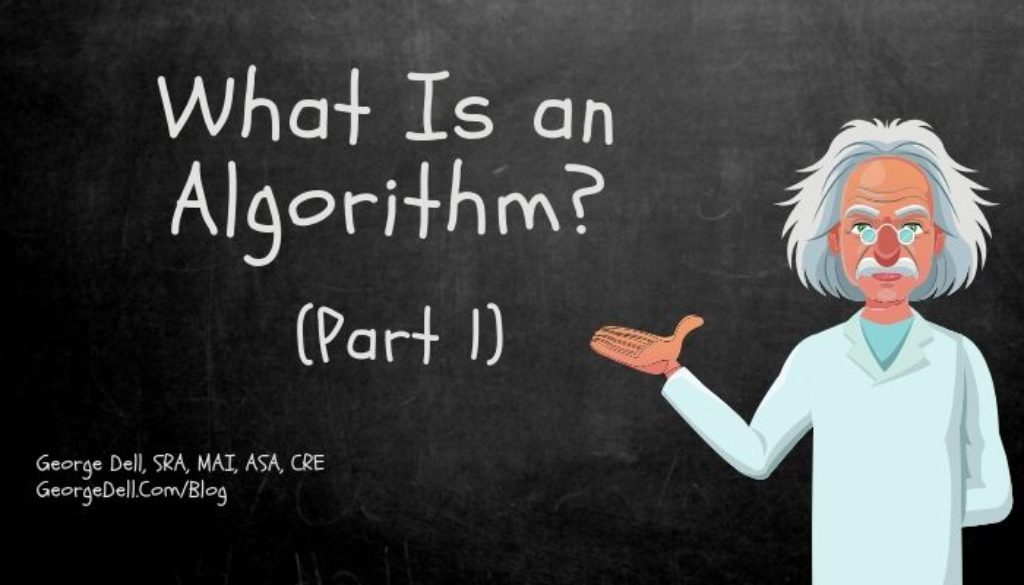A student recently asked this question (algorithm) in a Stats, Graphs, and Data Science1 class. It is an important concept for the future of asset analytics. Yet the class did not really explain or even define the word. Is it about thinking? About computation? Or is it like a new approach to value?
To explore this word, we must have the right context. The context for algorithm does not fit well into the legacy ‘appraisal process’, now called the ‘valuation’ process in the current edition of The Appraisal of Real Estate. In this blog, we look at the place of algorithms in traditional, judgment-based practice.
In part 2, we consider the role of algorithms in EBV© (Evidence Based Valuation©). In part 3, we relate how the appraiser-analyst can apply them to provide work which is faster and provides better value to the client, particularly in the area of risk assessment. Finally, in part 4 we bring together modern computation concepts, using integrated, reusable algorithms in practice using R analytics.
An algorithm is generally defined in two ways, equally relevant:
- A set of rules for solving a problem;
- A sequence of computer programming steps.
An algorithm should assist in providing answers to decisions about assets which can include derivative assets such as loans secured by other assets. What kinds of analytic answers might be helpful to an investor, consumer, speculator, risk analyst, or portfolio manager?
So how does this compare to the appraisal process?
In simplest terms, an appraisal is “the act or process of developing an opinion of value.
Implicit in the traditional definition of appraisal is the idea that an appraisal is someone’s opinion, rather than an undeniable fact. The Appraisal of Real Estate, 14th ed., p. 2
“The appraisal (valuation) process” does provide a “set of rules” for solving a problem. But the problem is in the stated solution. The snag, the dilemma – is the how the solution is defined. The traditional appraisal process result is defined as an opinion.
The process also starts out as opinion or judgment of the data or information. A subjective start to a subjective end. The appraiser starts out with an opinion of “what is comparable?” then selects the “best” four or five comparables as the algorithm’s starting data set. “What is ‘best’” is not defined. “Comparable” is not defined. (The explanation available is circular in nature: A comparable is able to be compared!)
The “appraisal” algorithm then proceeds to consider locational data, subject data, and comparable data. After the data is selected, a market analysis is performed, and then and only then does the appraiser consider the “Highest and Best Use”. Curious. Pick the data, then consider whether it matters. Then an opinion of land value. Then three sub-algorithms, (three approaches) which partially overlap, requiring judgment/opinion reconciliation explanation of why differing results arrive!
Basically, the whole system says: “Form an opinion” then figure out how to “support your opinion.”
The data science view looks, acts, and sounds different. The start of the process is similar. But the rest is different. In Part 2, we will look at the role of algorithms in the Data Science Approach to valuation.
The August 2019 TAAR© (The Asset Analyst Report©) sets out an extended description of the four core data science algorithms used in asset analytics. TAAR© is George Dell’s paid subscription report designed for those preparing for a career in asset assessment.
Editor’s Note: Link to Algorithm Part 2 is here

August 21, 2019 @ 8:05 am
Thanks for introducing us to this timely concept. Unlike the long-winded abstract formulae currently used to “prove” our values, this concept(s) appears to apply a whole army of different proofs that is based on science and not on “gut.” and smoke and mirrors. Rest assured, I will follow these steps into assest analytics with much interest.
October 4, 2019 @ 8:14 am
Yes, current appraisal process is also a set of steps, but is based on subjective data selection (picking comps), and unworkable adjustment formulae.
The old appraisal body of knowledge was great in the old days. But it gets in the way of modern predictive science.